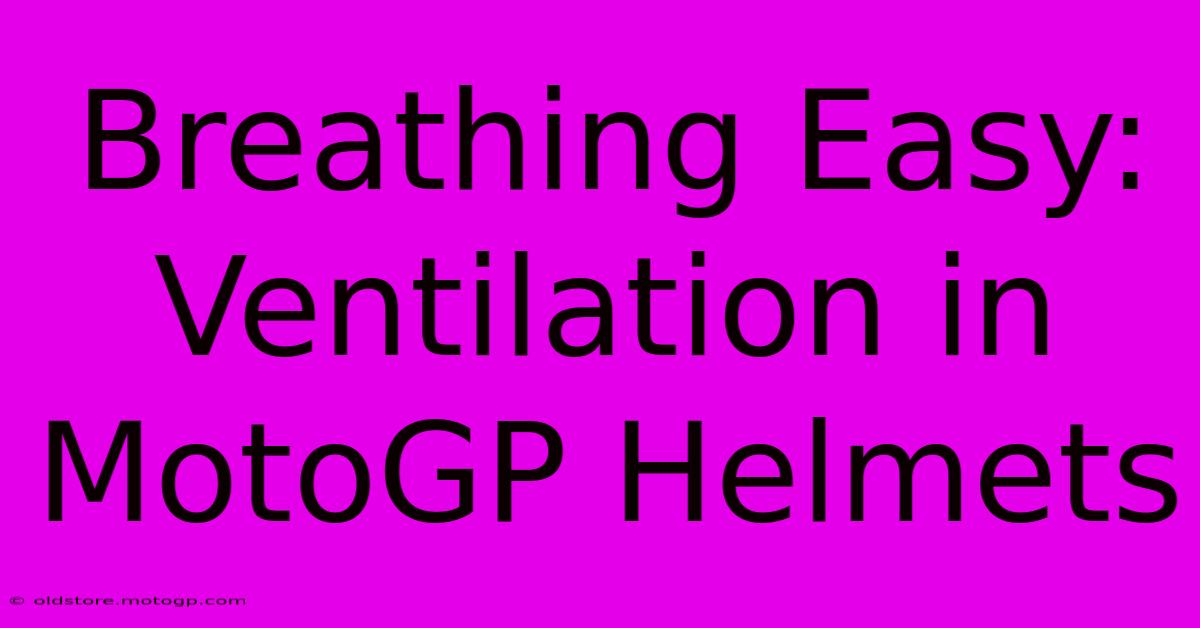Breathing Easy: Ventilation In MotoGP Helmets

Table of Contents
Breathing Easy: Ventilation in MotoGP Helmets
MotoGP racing pushes riders and their equipment to the absolute limit. While speed and horsepower dominate the headlines, a crucial, often overlooked element contributing to rider performance and safety is helmet ventilation. In the intense heat and physical exertion of a race, proper airflow inside the helmet is not just a comfort issue; it's vital for rider concentration, performance, and even safety. This article delves into the sophisticated ventilation systems found in MotoGP helmets, exploring the engineering and design choices that keep riders breathing easy under extreme conditions.
The Importance of Helmet Ventilation in MotoGP
The demanding nature of MotoGP necessitates exceptional helmet ventilation. Riders experience:
- Extreme Heat: Engine heat, sun exposure, and intense physical effort generate significant heat inside the helmet. Poor ventilation leads to overheating, dehydration, and impaired cognitive function.
- Fogging: Moisture from sweat and breath can fog the visor, drastically reducing visibility – a critical safety hazard at high speeds.
- Reduced Concentration: Discomfort from heat and moisture distracts riders, affecting their focus and decision-making abilities.
Effective helmet ventilation mitigates these issues, allowing riders to maintain peak performance and safety throughout the race.
Helmet Design and Ventilation Technology
Modern MotoGP helmets are engineering marvels, incorporating advanced ventilation systems. Key design elements include:
Multiple Air Intakes:
Strategically placed intakes on the chin bar, forehead, and crown direct airflow into the helmet. These intakes are often adjustable, allowing riders to customize airflow based on conditions. The size and shape of these intakes are meticulously engineered using Computational Fluid Dynamics (CFD) to maximize airflow efficiency.
Internal Air Channels:
A network of internal channels directs the incoming air across the rider's head and face. These channels are carefully designed to ensure even airflow distribution, preventing stagnant air pockets. Materials and construction techniques are chosen to minimize air resistance within these channels.
Exhaust Ports:
Exhaust ports at the rear of the helmet expel hot, humid air, creating a continuous airflow cycle. The positioning and size of these exhaust ports are crucial in maintaining optimal pressure differentials for efficient airflow.
Advanced Materials:
Lightweight yet strong materials like carbon fiber are commonly used, minimizing weight while maximizing structural integrity. The choice of materials can also affect the overall aerodynamic performance of the helmet, potentially impacting ventilation efficiency.
Beyond the Basics: Innovations in MotoGP Helmet Ventilation
Manufacturers constantly strive to improve ventilation technology. Recent innovations include:
- Active Ventilation Systems: Some helmets incorporate small fans powered by batteries to enhance airflow. These systems offer significant advantages in extremely hot and humid conditions.
- Hydration Systems: Integrated hydration systems allow riders to stay hydrated without removing their helmets, maintaining focus and reducing the risk of dehydration-induced fatigue. These systems often work in tandem with ventilation systems to prevent moisture buildup inside the helmet.
- Aerodynamic Optimization: Helmet designs are constantly refined using wind tunnel testing to improve airflow and minimize drag, ultimately enhancing ventilation efficiency.
Conclusion: A Breath of Fresh Air for Performance and Safety
In the high-stakes world of MotoGP, even the smallest details can make a significant difference. The sophisticated ventilation systems found in modern MotoGP helmets are a testament to the importance of rider comfort and safety. These systems, a result of continuous innovation and engineering excellence, directly contribute to rider performance, allowing them to focus on what matters most: conquering the track. The pursuit of better ventilation will undoubtedly continue, driving further advancements in helmet technology for years to come.

Thank you for visiting our website wich cover about Breathing Easy: Ventilation In MotoGP Helmets. We hope the information provided has been useful to you. Feel free to contact us if you have any questions or need further assistance. See you next time and dont miss to bookmark.
Featured Posts
-
Moto Gp Sprint The Heart And Soul Of Moto Gp
Feb 19, 2025
-
Cota Lot H State Of The Art
Feb 19, 2025
-
Cota Your Motorcycles Dream Come True
Feb 19, 2025
-
Formula 1 Or Moto Gp Which Is More Thrilling
Feb 19, 2025
-
Get The Inside Scoop Moto Gp Sprint Race Results And Expert Commentary
Feb 19, 2025
